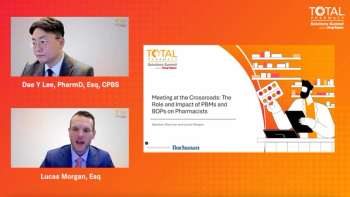
CMS pay-for-performance pilot engages R.Ph.s
The clinical success of an ongoing pay-for-performance (P4P) pilot project by the Centers for Medicare & Medicaid Services requires extensive participation by health-system pharmacists.
Ade is referring to her facility's multidisciplinary team of doctors, nurses, quality improvement staff, and pharmacists. They created treatment protocols for participation in the P4P initiative. "The original hypothesis was to discover whether financial incentives could improve the quality of care," said Leigh Ann Myers, R.N., national director of clinical service for Premier Inc., a San Diego-based nationwide alliance of about 1,700 not-for-profit hospitals, which is participating in the ongoing pilot. "But we discovered much more."
The P4P model used in the project includes financial incentives for the top 20% of hospitals in each of the five clinical areas. The top 10% of hospitals receive a 2% incentive payment for patients in that clinical area, based on each hospital's existing Medicare reimbursement in each clinical area. Those hospitals in the second decile receive a 1% incentive payment. Hospitals in the top 50% of each clinical area receive public recognition on the CMS Web site. Hackensack University Medical Center (HUMC) in Hackensack, N.J., was a top performer in all five areas, and received about $744,000.
"A large part of the commitment and design of the project was the ability to share and learn," said Regina Berman, R.N., M.A., HUMC's administrative director for performance improvement, in a press conference announcing the reward. "We committed to transparency, and we have, I think, shamelessly shared and stolen from each other basically at all levels."
Collegiality also contributed to success within facilities. A willingness to include all disciplines in the development of standards was the key to Homestead's success, said Jill White, R.N., director of performance improvement. "Pharmacists were instrumental," she said, "especially in the areas of developing and implementing standards and measures for heart disease and community-acquired pneumonia [CAP]." Homestead is doing well in the pilot: In compliance with AMI measures, the 120-bed community facility scored in the top 10% of participating hospitals in the recent disbursement and in the top 20% for CAP measures.
The role of Homestead R.Ph.s began with a review of evidence-based standards and extended to the creation of standardized forms to guarantee compliance, said Ade. "Consistency is the key to success and improved quality," she said. "And consistency is founded on follow-up."
Newsletter
Pharmacy practice is always changing. Stay ahead of the curve with the Drug Topics newsletter and get the latest drug information, industry trends, and patient care tips.










































































































































































































